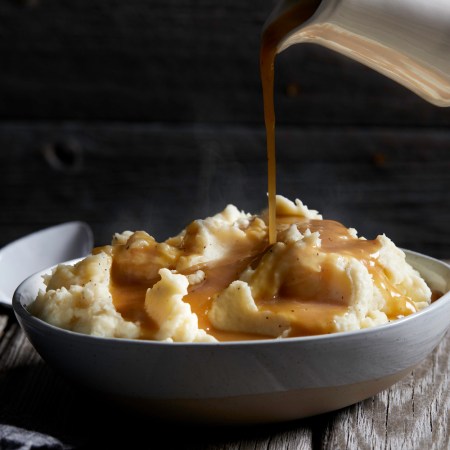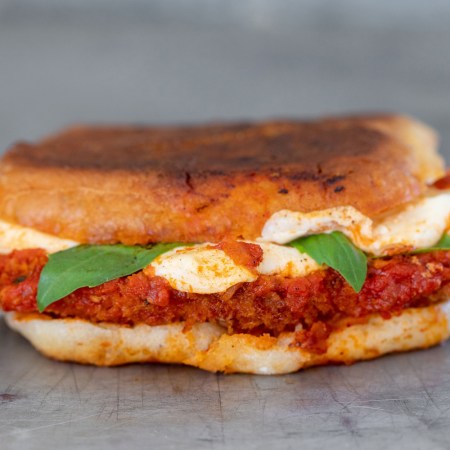Alongside deli standbys like tangy coleslaw, pickled eggs, Kosher-style pickles and hot yellow chili peppers, Philippe’s on North Alameda in L.A. serves up mouth-watering portions of roast beef, roast pork, leg of lamb, turkey, ham or pastrami that have been dipped in their own natural gravy on freshly baked French rolls.
Possibly named as a sort of double entendre nodding to a French fashion trend in the late 19th century that saw women allow their belts to dip below the waist, Philippe’s “French Dipped Sandwich” was inadvertently made for a police officer in 1918 by the eatery’s original owner Philippe Mathieu, who allegedly dropped a sliced French roll into a roasting pan filled with meat juice. The officer, undaunted, ate it, and the French Dip was born. (Another LA eatery, Cole’s, lays a far shakier claim to being the first home of the first dip. For once, we’ll side with the Frenchman.)
In the decades since, the French dip and its accompanying sidecar of au jus has become an American national treasure that can now be found on menus at bars, restaurants and sandwich spots across the U.S. Though not always a fixture, the satisfying sandwich can also be found at many delicatessens, including Brent’s Comfort Kitchen, a delivery-only deli that opened in NYC in late spring.
Named for owner Brent Romanow, Brent’s Comfort Kitchen aims for deli classics at a cost that won’t break the bank.
“My sandwich prices are about anywhere from $3 to $6 less than the competitors and they have the exact same amount of meat. We use eight ounces evenly distributed across the sandwich,” Romanow tells InsideHook. “A pet peeve I have about the classic deli is the sandwiches are stacked in a way that makes them look huge, but not very friendly to eat. They roll all the meat up in a ball, put it in the center and cut it. The sandwich looks like it’s overflowing, but by the time you unwrap it to put dressing on, it falls apart in your hands. Ours hold together up to the last bite and are a pleasure to dress, eat and hold. Our deli sandwiches also come with everything. Coleslaw, pickles and unlimited dressings, which is a thing I don’t think you should pay extra for. If you’re paying $19 for a sandwich, you want a whole meal.”
Made with a thinner-sliced version of the meat Romanow uses for his roast beef sandwich, the made-to-deliver French dip from Brent’s isn’t four courses, but it certainly counts as a meal. Served with one container each of fresh horseradish cream, coleslaw and au jus for dipping purposes, Brent’s French dip comes on toasted bread with Swiss cheese and a cherry pepper garnish.
The bread, cheese and other ingredients are all important, but Romanow believes the dip’s beef, which is cured during a two-day process, is what really ties the sandwich together.
“The most important thing with the beef is the thinness of the slice,” he says. “If you’ve got thick pieces, it’s going to come out like a weird steak sandwich. Most people don’t sauté their steak sandwiches. It’s more of a grilled thing. So the thinness of the beef is paramount because you don’t want to overcook or dry out the meat or use up all of your au jus when you’re cooking it. You want that meat to brown fast and hydrate with the au jus, very quickly. The thinner it is, the easier that’ll be.”
Equally as easy? The decision to put the French dip on the menu at Brent’s.
“I’ve always absolutely loved a French dip. Having my own sandwich shop and deli, it was something I decided I needed to have,” Romanow says. “From my perspective, it’s in the same category as a Philly cheesesteak or a BBQ brisket sandwich on a big roll. Those meatier, heavier sandwiches. It’s in a separate category from a lot of the typical sandwiches people are eating. It’s more of a full meal because you have a broth to dip in. Whereas a turkey club is more of an on-the-go and cold-served item. The French dip stacks up in a category of its own and it has a special place on the menu at our Jewish-style deli.”
If you follow Romanow’s French dip recipe, the French dip can have a special place in your kitchen too — before carving out a special place in your stomach.
Brent Romanow’s French Dip for Two
Ingredients
- 1 lb Rare Roast Beef, thinly sliced
- 2 cups Au Jus (see recipe below)
- 2 Tbsp Mild Cherry Pepper, thinly sliced
- 6 slices Swiss Cheese, medium thickness
- 2 7” Italian Hero Rolls
- Creamy Horseradish (see recipe)
- 2 Whole Cherry Peppers
Instructions
- Heat roast beef, au jus, cherry peppers and 2 slices of the Swiss cheese in a 10” skillet or sauté pan.
- Cover with a lid and bring to a boil. Stir with tongs so that all the meat gets heated through and the cheese melts into the liquid. Don’t let the jus evaporate!
- While the beef is heating, slice hero rolls in half. The top half should be slightly thinner than the bottom half. Toast both sides until golden brown in the broiler or toaster oven.
- When the meat is done, strain off the jus into 2 serving bowls for dipping. Using tongs, divide the meat onto the bottom buns. Top with the reserved Swiss cheese slices.
- Melt the cheese in the broiler or toaster oven (this won’t take long, so watch carefully).
- Top with the toasted top bun. Slice in half on the bias.
- Serve with the hot au jus, creamy horseradish sauce and whole cherry pepper to garnish.
Au Jus Ingredients (yields two cups)
- 2 tsp Better Than Bouillon Roasted Beef Base
- 2 cups Water
- 1 ½ tsp Frank’s Red Hot Sauce
- 1 ½ Tbsp Worcestershire Sauce (Lea & Perrins)
- 2 Tbsp A1 Steak Sauce
- 2 Tbsp | Soy Sauce
Instructions
- Heat water and beef base in a small saucepot. Whisk to combine. (We prefer “Better Than Bouillon Brand,” but use what you have on hand.)
- Stir in the remaining ingredients.
Ingredients for Creamy Horseradish
- 1 cup Sour cream
- 2 Tbsp Dijon mustard
- 3 Tbsp Prepared Horseradish, drained of excess liquid
- 1 pinch Ground black pepper
- ½ tsp Salt
Instructions
- Combine all ingredients in a small bowl. Use more or less horseradish, according to your taste.
This article was featured in the InsideHook newsletter. Sign up now.






















